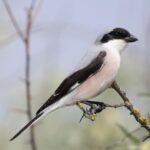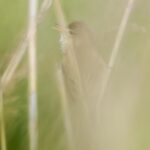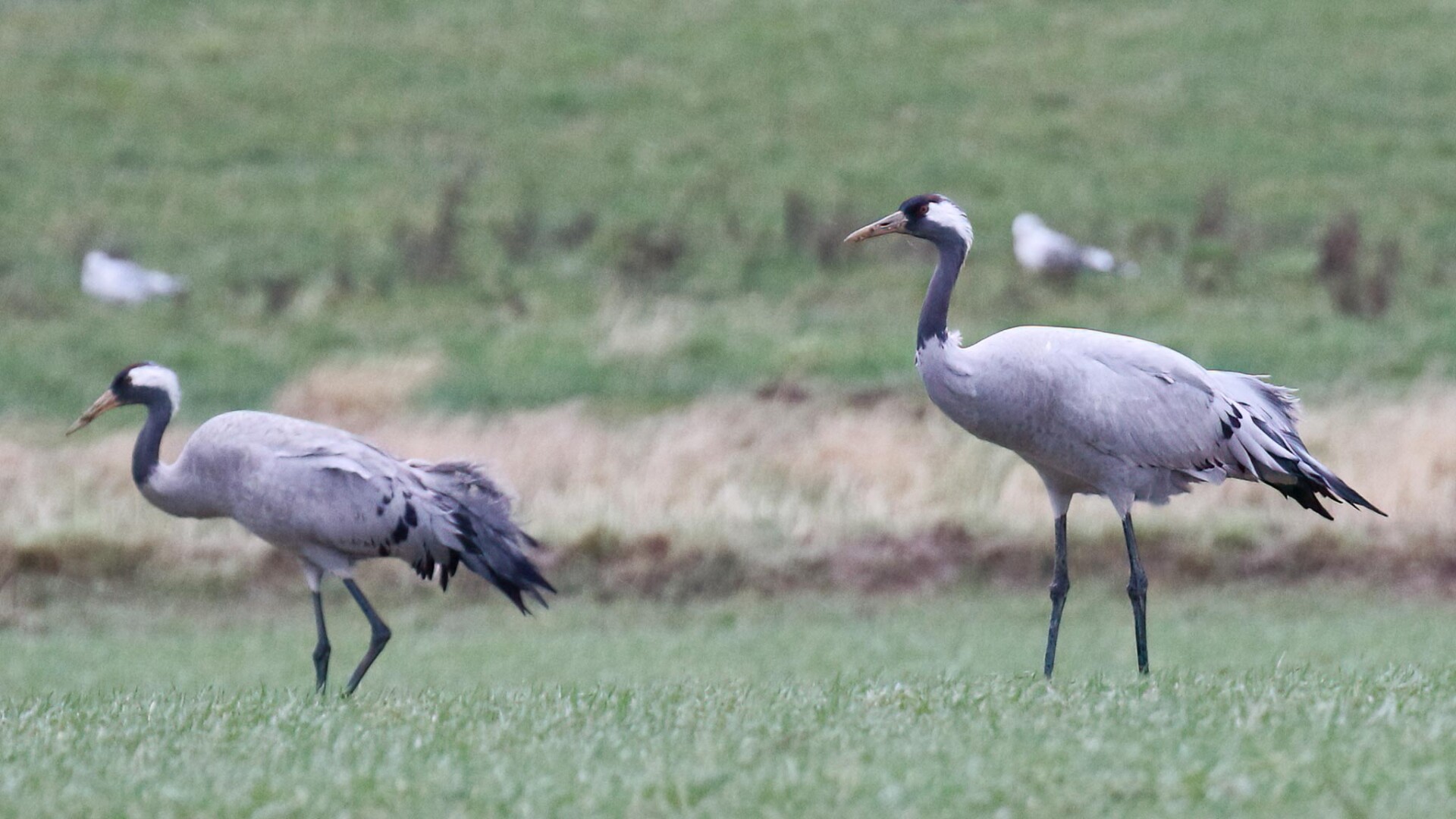Day 1 of a 3-day Early Winter Tour in Norfolk. After a very frosty start, we had some nice bright sunny spells but also some heavy wintry showers, which were not really in the forecast. We managed to largely dodge them until later in the afternoon.
We are currently enjoying an influx of Waxwings, so with a group reported in Holt the last few days we decided to swing round via there on our way to the coast first thing. It was a very cold and frosty morning, and when we got out of the minibus there was no sign of any Waxwings – were we still too early? We walked up to the top of the Close, where a Coal Tit was calling in the trees at the far end as we walked underneath.
We figured we might have to try again later, but as we walked back towards the minibus we noticed a shape perched in the top of a tall tree between the roofs of the houses. A lone Waxwing! It dropped down to feed on the berries on a smaller tree, right next to where we had parked, and then flew up into the top of another tree further up. We had a nice view of it here through the scope, as it perched looking round. Perhaps it was looking for the rest of the flock?!
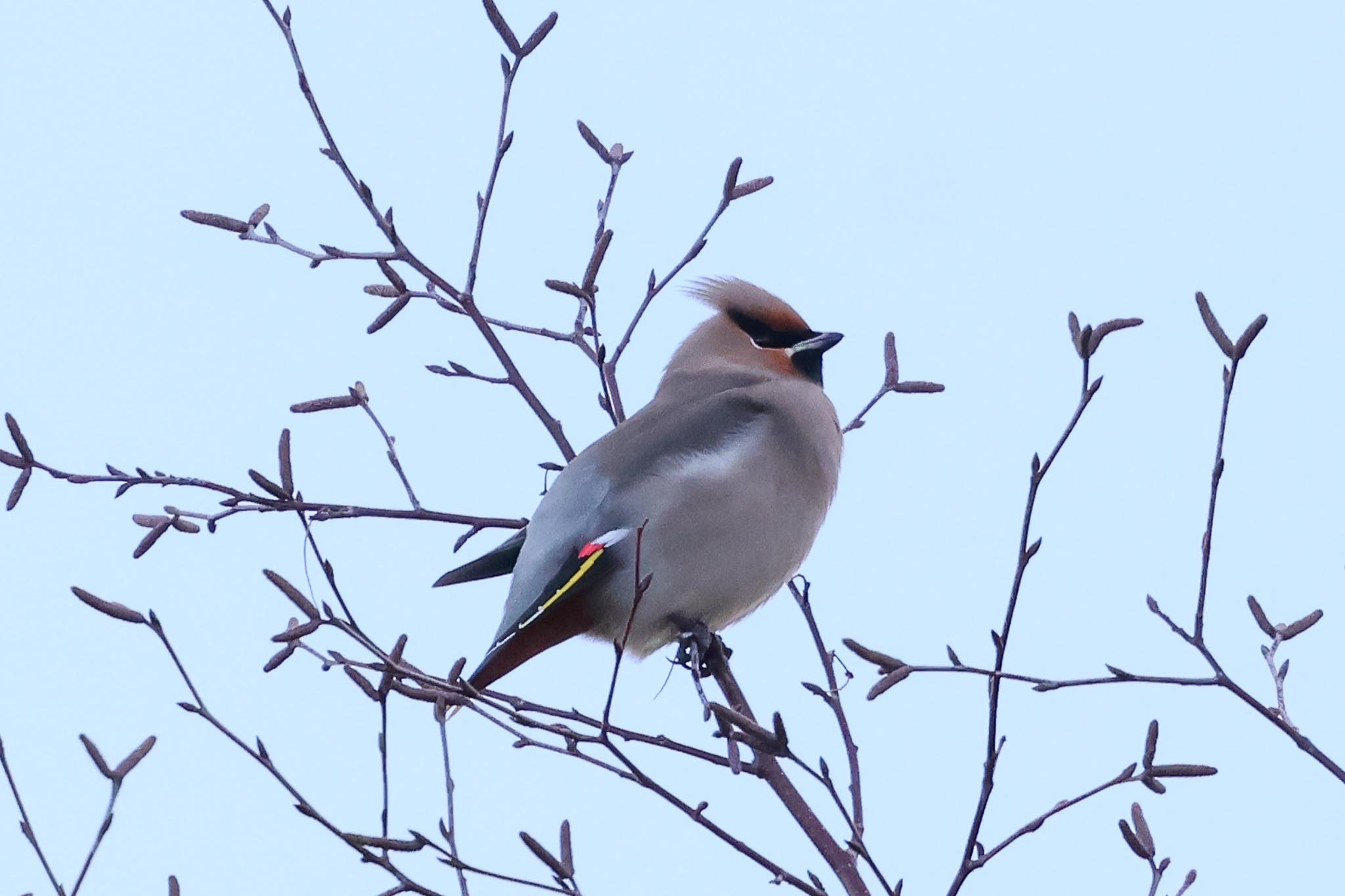
We were just thinking we might have to settle for only the one when a flock of birds appeared flying in low over the roofs. More Waxwings, another 17 of them. They landed on the TV aerial of one of the houses, quite a sight packed in tight together, then started to drop down to feed on the berries below.
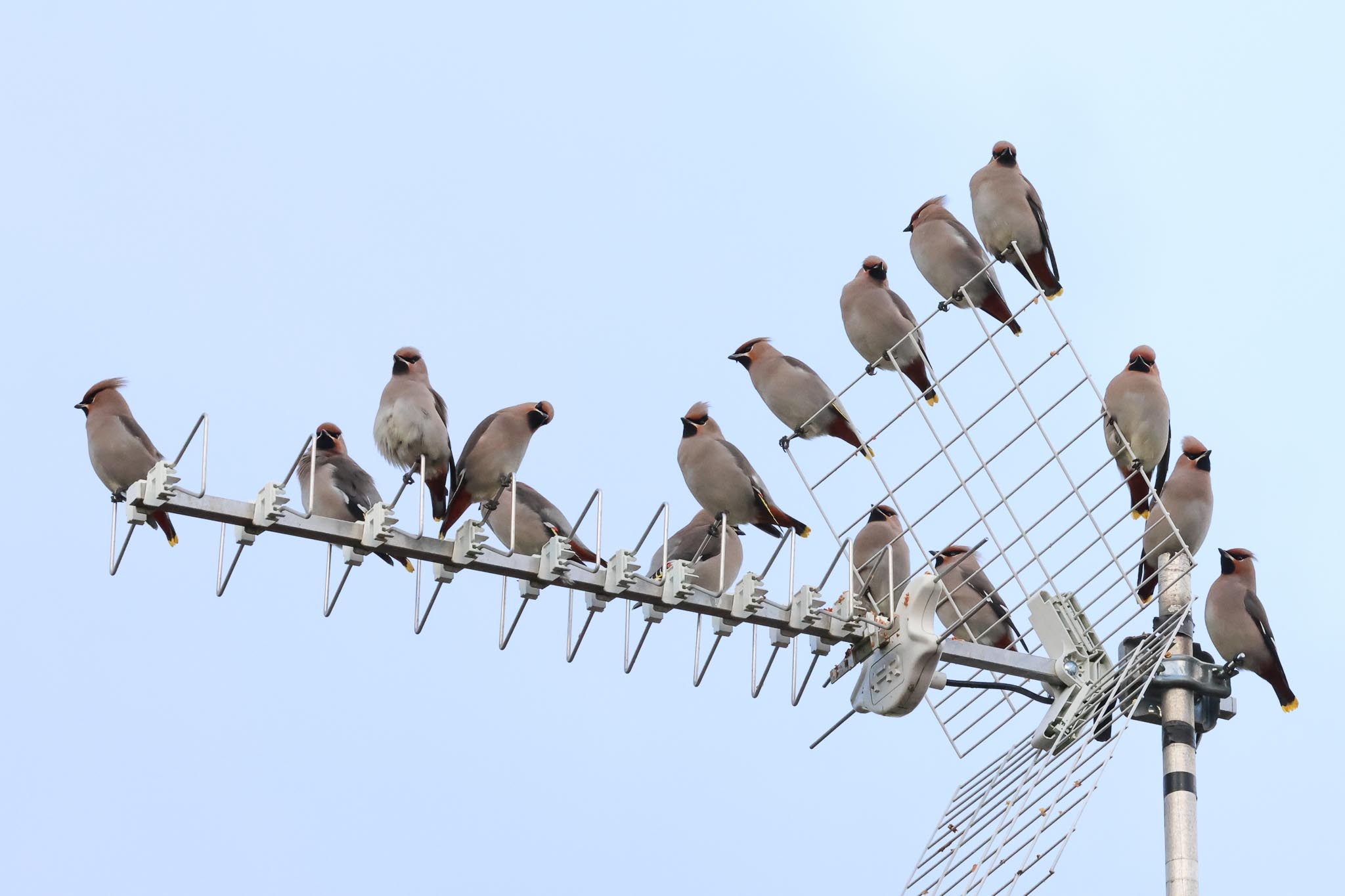
They didn’t stay long, and then flew back up, some moving on to a nearby tree where they perched preening in the early winter sunshine. Great light now, through the scope. A Red Kite flew in from the other direction and over the Waxwings, which barely batted their spiky crests. Then an ominous dark cloud drifted over and it started to snow. We decided to get back in the warmth of the minibus and move on.
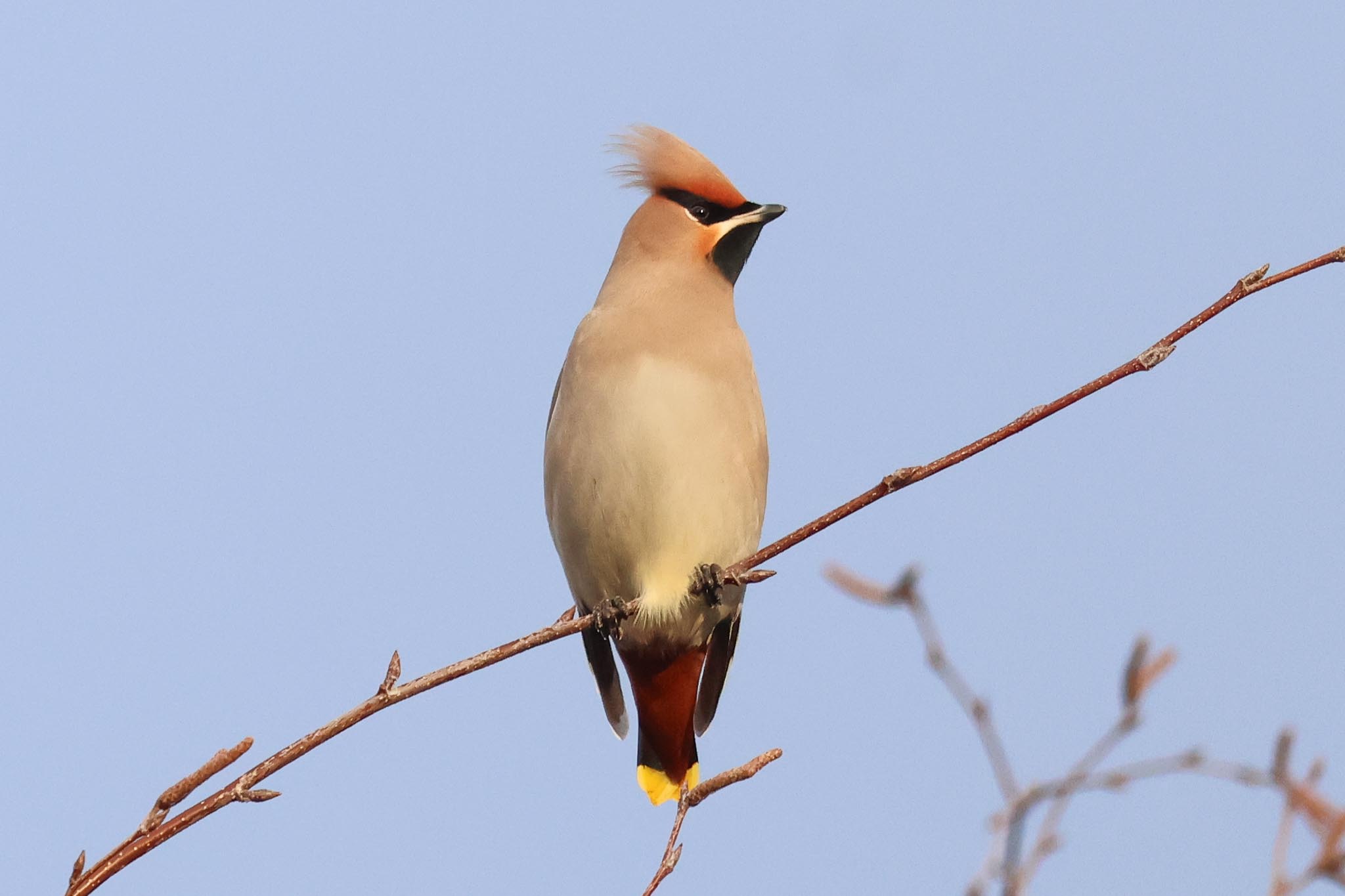
By the time we got down to Cley, the sun was out again and the skies were blue. We parked at Walsey Hills and as we walked past Snipe’s Marsh, the sun was catching the tops of the reeds, a classic winter scene. Up onto the East Bank, a pair of Gadwall were down in the Catchwater Drain, looking very smart in the low winter sunshine.
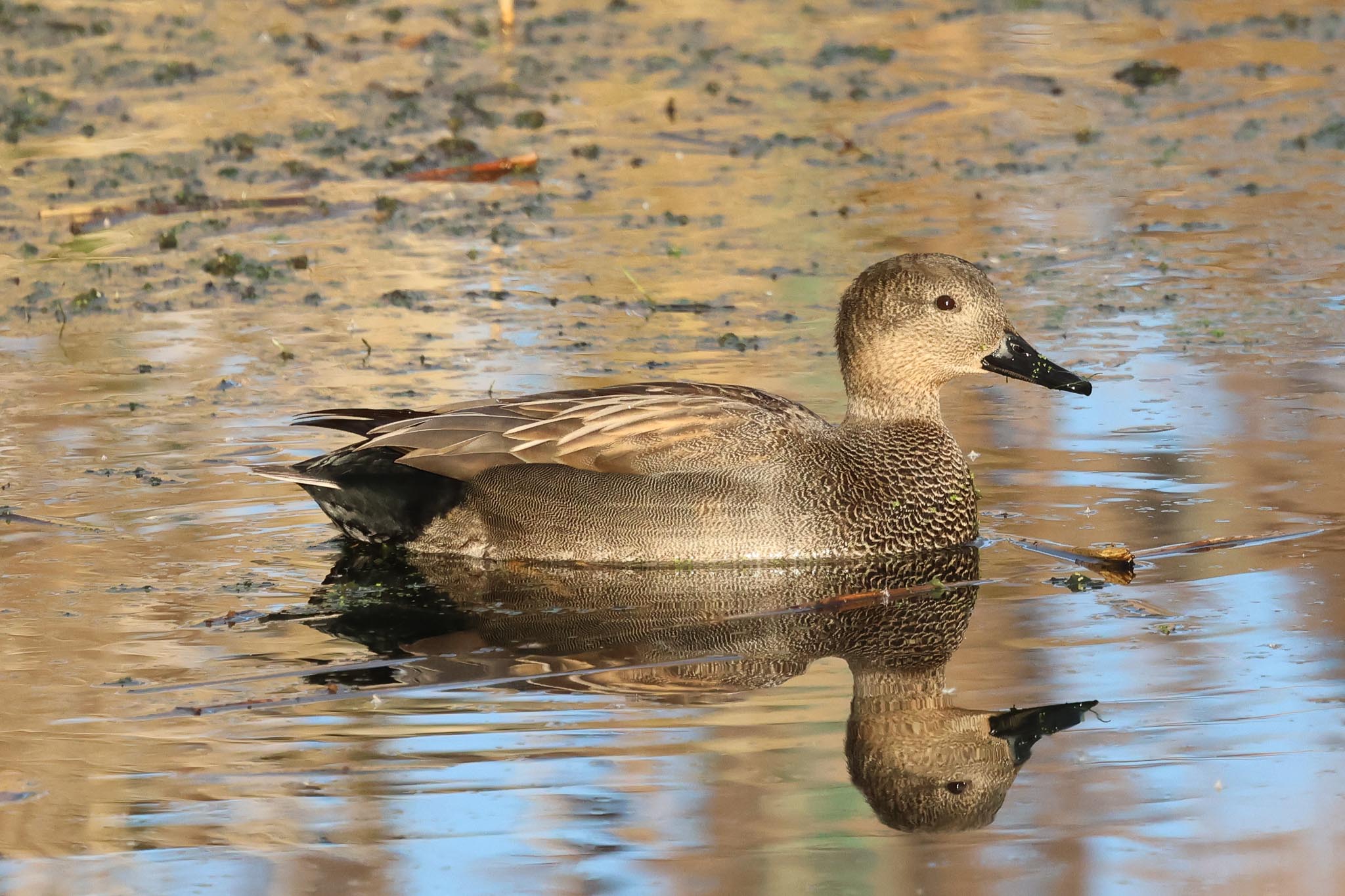
A rather grey-backed Robin was flitting back and forth across the start of the Skirts path, presumably a continental bird arrived to spend the winter here. As we walked on, a couple of Marsh Harriers flew round low over the reedbed and while we were watching one of them, a Kingfisher shot past and dropped down into the ditch beside the bank ahead of us.
It seemed like a perfect morning for Bearded Tits, but they were a bit slow to get going this morning. About half way up, we heard some calling close to the path but there was no sign in the tops of the reeds. We stopped to see if they might appear – a Cetti’s Warbler called in front of us and another shouted from back along the bank, a Reed Bunting called further ahead, but the Bearded Tits had gone quiet. We thought we might stand a better chance on the way back.
We scanned out across the Serpentine towards Pope’s Pool. There were lots of Wigeon whistling on the grazing marsh and more Teal and Shoveler around the edges of the water. A couple of small flocks of Pink-footed Geese flew over calling. There were lots of Lapwing in the grass too and we turned the scope on a group to admire their metallic green upperparts which glowed in the sunshine. A small group of Dunlin were feeding around the mud in front of them.
Continuing on, we heard the Kingfisher again and it flashed across the path ahead of us and disappeared off out over the reedbed. Up to the main drain, and a Curlew was feeding on the bare mud where the diggers have sculpted the new cut. A Little Grebe was in the water in front.
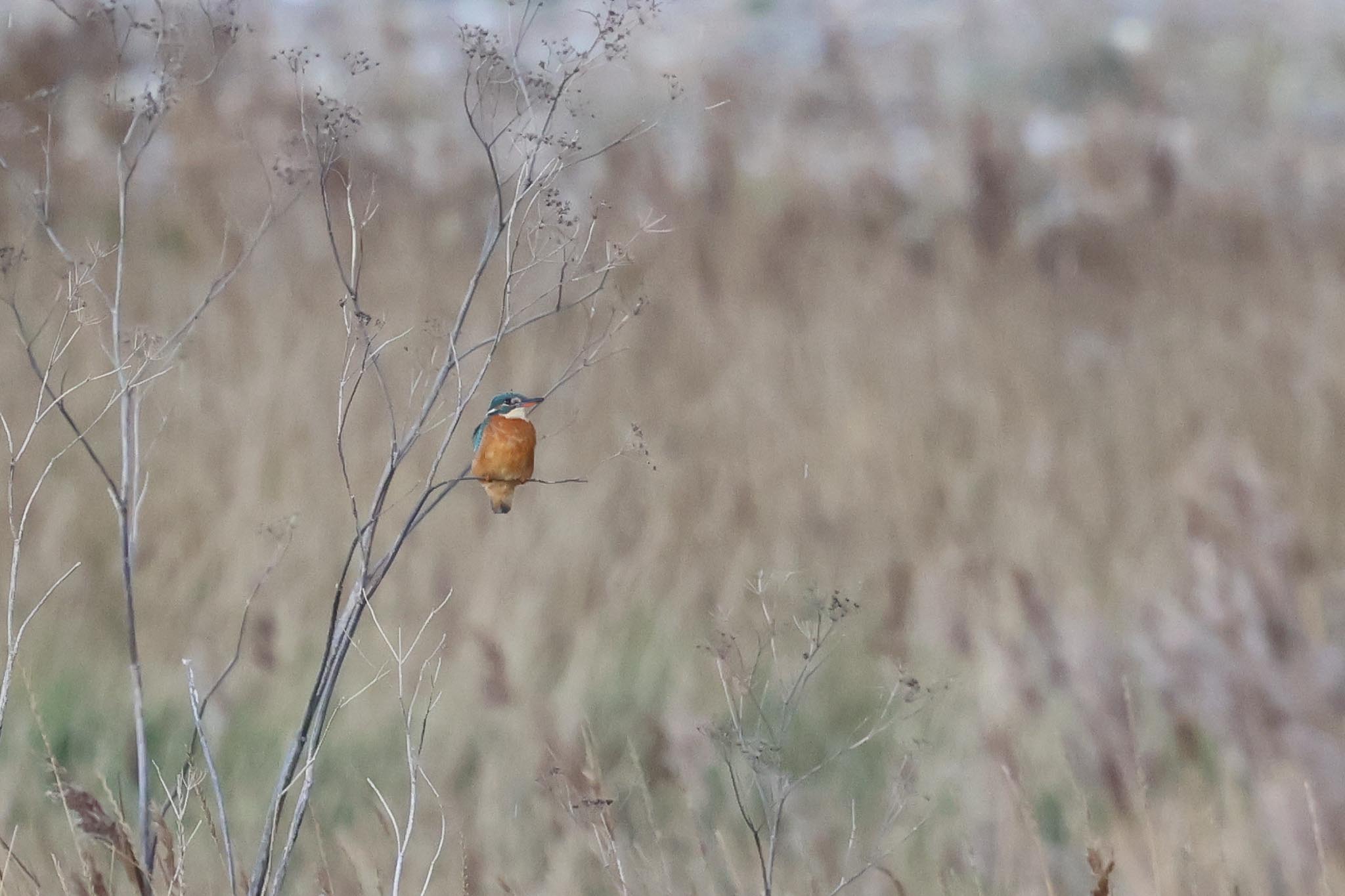
We could see more ominous clouds out to sea and it was clearly sleeting away towards Sheringham already, so we decided to stop here and scan rather than continue on to the beach just yet. There were lots more ducks on the brackish pools but we couldn’t dig out a Pintail this morning. Another Kingfisher was hovering over the water close to the path further up – it kept hovering and then moving position, then hovering again. It landed in some dead plant stems just beyond the water for a quick break, then resumed its fishing, eventually catching something and then disappearing off over the reeds.
As it started to sleet, we moved into the shelter overlooking Arnold’s Marsh, where there were more ducks but nothing we hadn’t already seen. Still no Pintail! A Weasel occasionally appeared out of the long grass in front of the shelter as it made its way past. At least we were out of the weather – the wind picked up and it was driving sleet for a few minutes, but thankfully the dark clouds moved through fairly quickly. Once it stopped, we headed out to the beach for a quick scan of the sea.
The shingle ridge has taken another battering from the storm last week and moved another few metres inland. Looking out to sea, four Common Scoters flew past, followed shortly after by five Eider, but otherwise there was very little out on the sea. We could see the heads of a couple of adult Grey Seals in the water and looking left, we could see a Grey Seal pup on the beach, which flopped down into the breakers. A Turnstone landed on the shingle in front of it.
There was a bite to the cold out on the beach, so we decided to walk back. Four Avocets had dropped in on Arnold’s Marsh while we were looking at the sea and when we stopped to look at them we finally found a pair of Pintail too, over in the far corner. It was still sleeting, although light now, so we made our way back quickly to the warmth of the minibus.
By the time we got to Wells, we could see blue skies again to the north-east and after a quick break to use the facilities, the sun was out again. We walked up past the lifeboat station to scan the harbour. Groups of Brent Geese were feeding on the near edge of the channel and a Grey Plover and a Curlew were in amongst them.
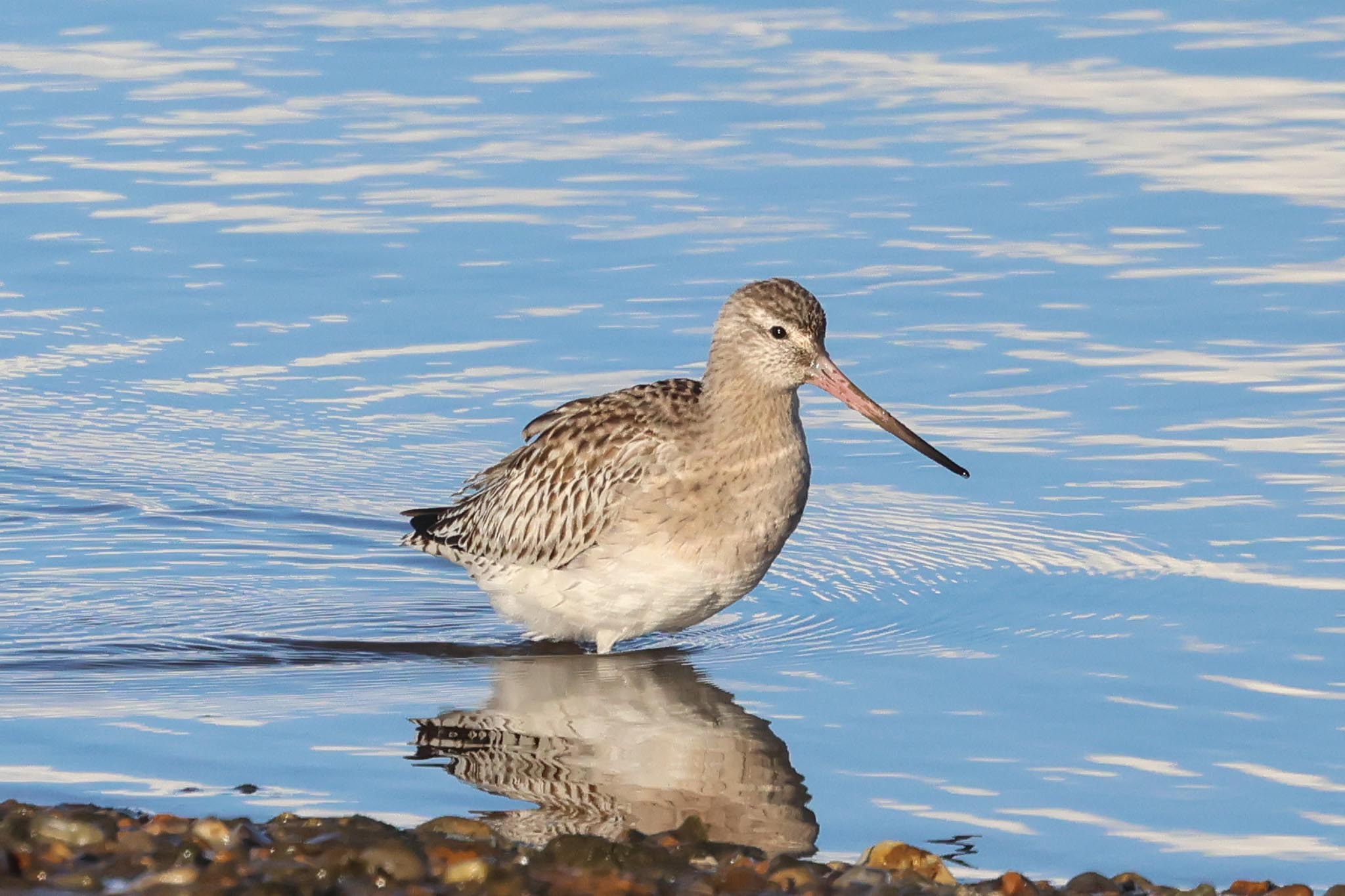
There were lots more waders on the mud beyond – lots of Oystercatchers, Bar-tailed Godwits, small flocks of Knot, Sanderling running up and down, Ringed Plovers, Turnstones, Dunlin and Redshank. A couple of Common Gulls were picking around on the stones on the low ridge opposite and a Herring Gull was trying to smash its way into a mussel by repeatedly flying up with it in its bill and dropping it on the stones.
A Razorbill surfaced in the channel in front of us a couple of times and was then carried by the outgoing tide further out to the outer channel. We could see a couple on Red-breasted Mergansers a bit further up so we walked round to the site of the old lifeboat station. We had great views of them here now, diving in the shallow water. Several flew off downstream but then came back – after a while we had seven Red-breasted Mergansers together. The males started displaying to the females, pointing their heads skywards and then throwing their rear ends up out of the water. Great to watch.
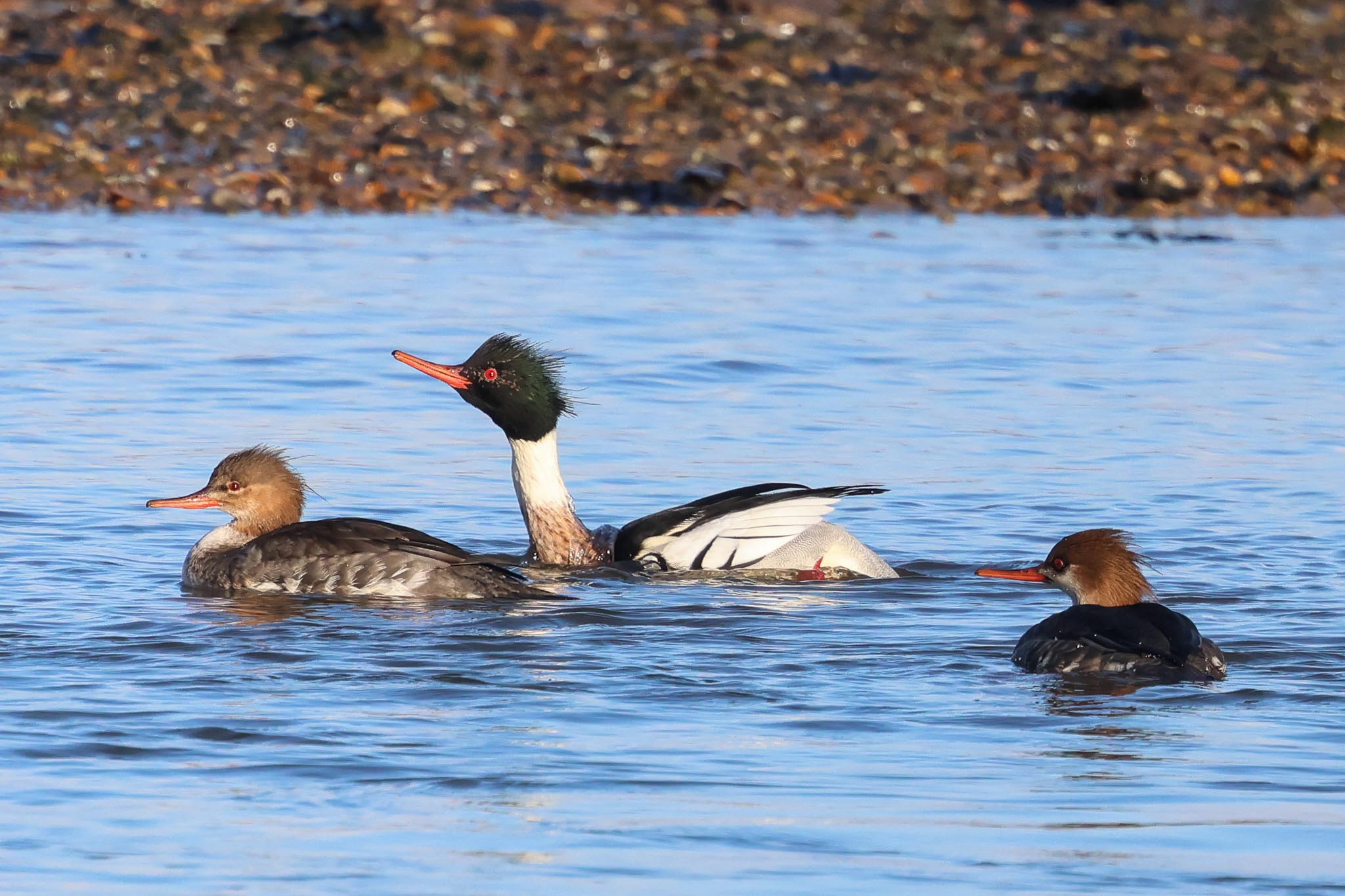
There is usually a Greenshank around in the harbour, but we hadn’t found it yet. After a while, it flew in from further up the channel, past us and landed further down on the small pools which had formed in the sandbar.
It was time for lunch. The picnic tables at the beach cafe were still very wet, so we headed round to Holkham, where the tables in front of the Lookout were a bit drier. As we drove up Lady Anne’s Drive, a couple of Marsh Harriers, a Red Kite, and several Common Buzzards were flying round in the sunshine. There were lots of Wigeon on the grazing marshes either side, but no sign of any Grey Partridge again – they seem to have largely deserted their favoured corner this winter.
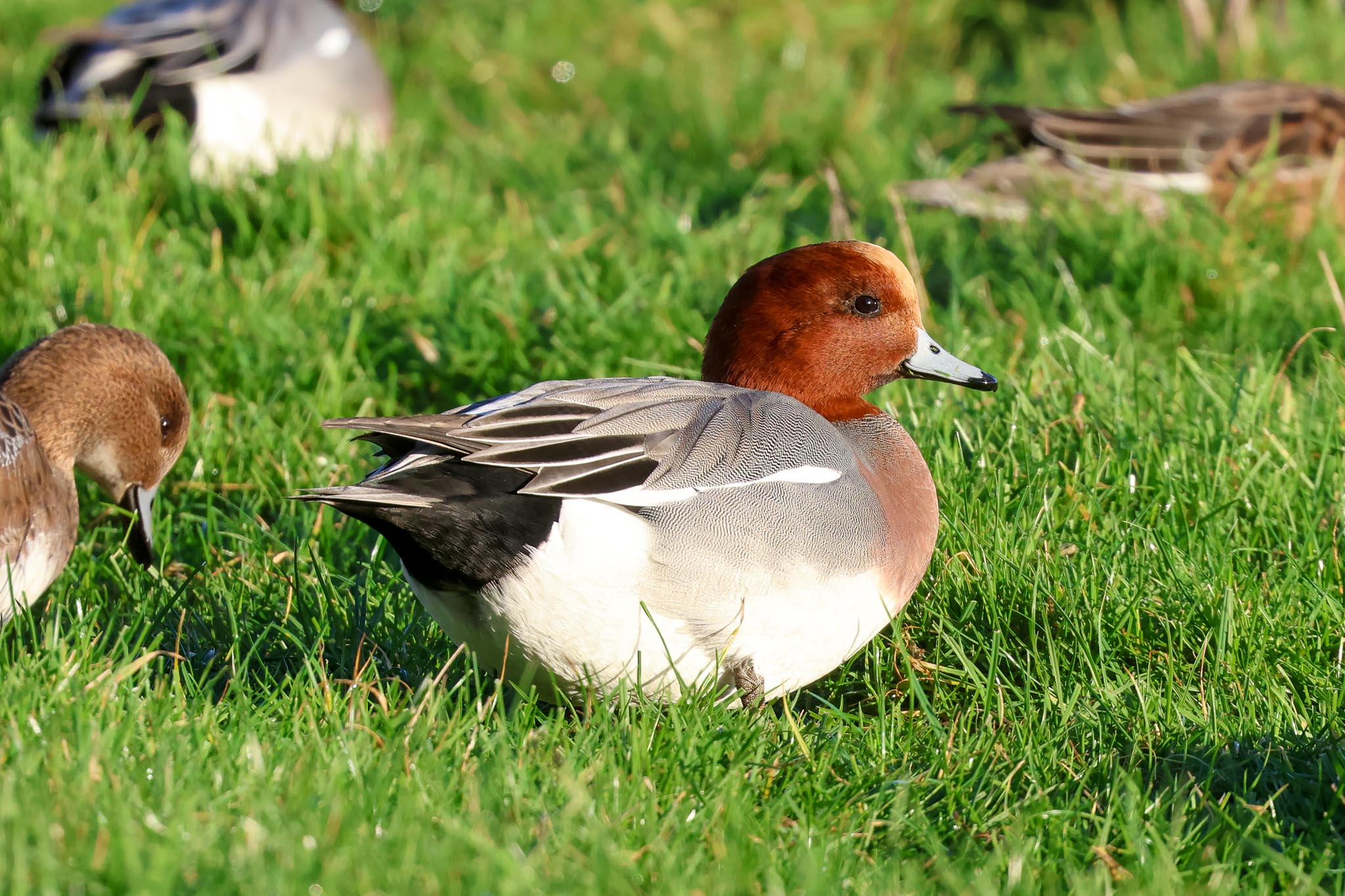
It was definitely a day where the weather couldn’t make up its mind today – blue skies and wall to wall winter sunshine now, we ate outside. A large flock of Pink-footed Geese came up from the grazing marshes behind the Lookout, flushed by one of the stockmen driving out, and they circled round yelping. A Mistle Thrush flew over and landed in the pines.
The Shorelark had been reported in the cordon just before lunch, but we asked some birders just coming back from the beach and they told us that they had only been seen there briefly and had flown off again. We walked out through the pines and as we got to the saltmarsh we scanned any likely areas as we walked east. We hadn’t gone far when we picked up some very distant small birds on the shingle on the east side of the Gap. They were partly hidden behind the bushes but they were the Shorelarks and from up on the edge of the dunes we could see them distantly through the scope.
The channel out in front of the Gap still looked to have quite a bit of water in it and we didn’t want to get feet wet, so we decided to go the long way round. We walked down to the start of the cordon and cut across towards the beach, before walking back on ourselves in the lee of the dunes. We could see more dark clouds now out over the sea, so we quickened our pace. The Shorelarks were still feeding on the beach and we got the scope on them. We had some lovely views in the low afternoon sun, their yellow faces catching the light.
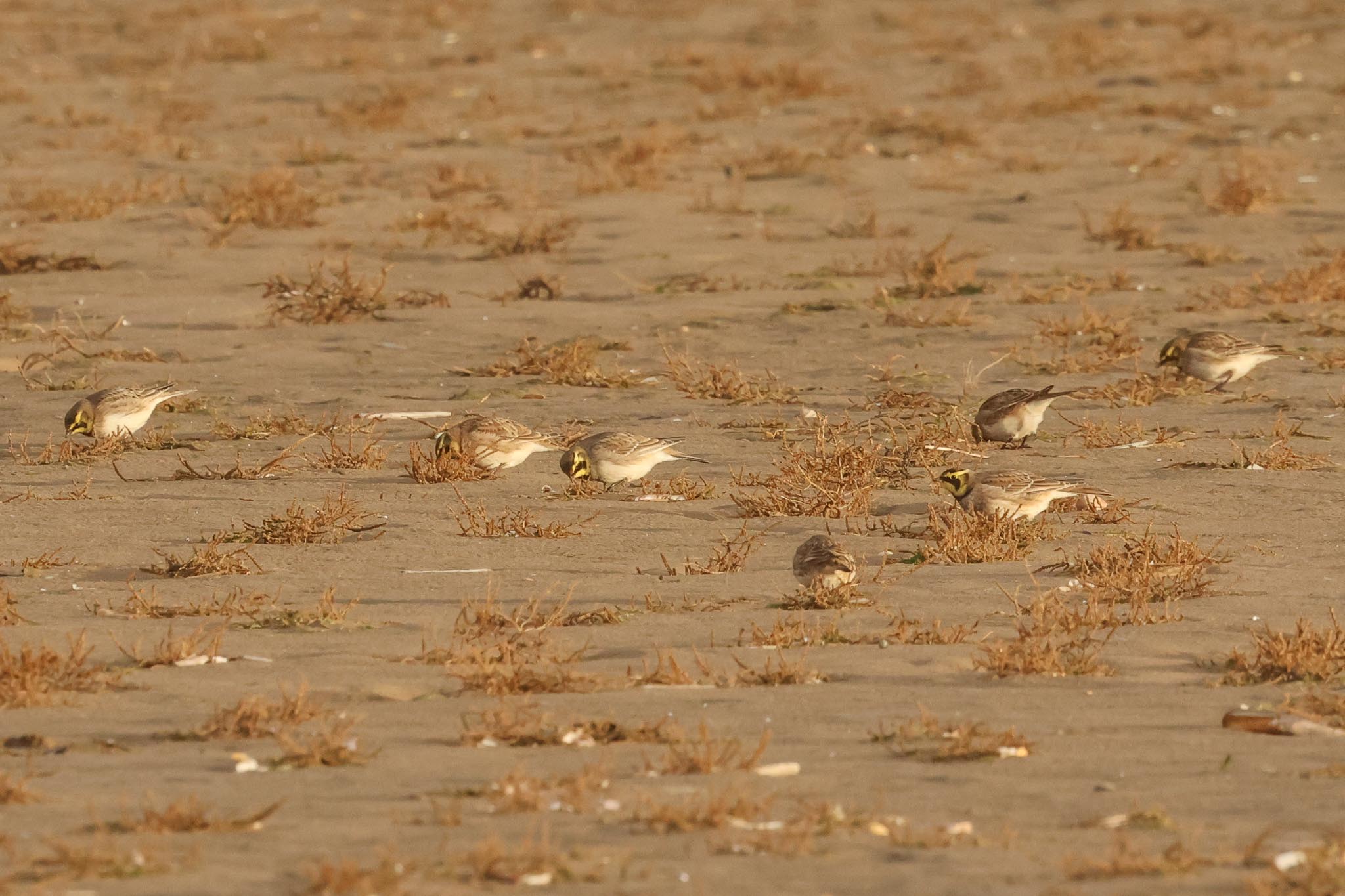
The dark clouds eventually caught up with us and it started to sleet again. We were in the lee of the dunes and could see some brighter sky beyond so we hoped initially that it might be another brief shower. However, a quick look from the top of the dunes and it was clear the bright sky was not enough to make a sailor a pair of trousers and was rapidly being covered away to the north of us. There was some very ominous thick cloud approaching. We decided we had to make a run for it, and head straight back. We found a shallow place to cross the channel and at least we had the wind largely at our backs as we crossed the saltmarsh.
We tried to have a quick scan of the grazing marshes from the warmth of the minibus, but it was hard to see much in the driving sleet now. It was brightening up away to the east, but the light was starting to go now, so we decided to head back and dry out.
